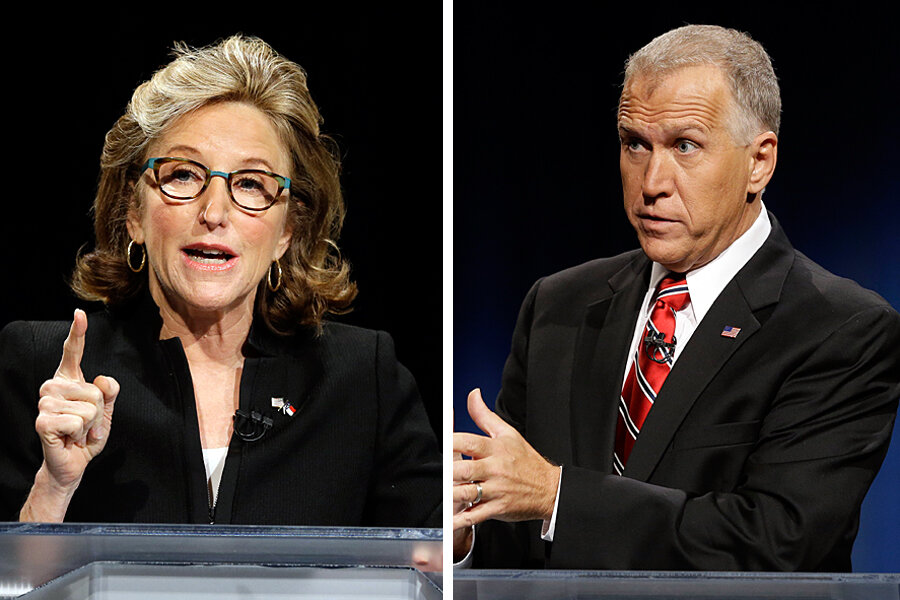North Carolina on track to have costliest Senate race ever
Loading...
| Washington
Kay Hagan and Thom Tillis aren’t household names across America, but their battle for the US Senate is on track to become the most expensive congressional race in US history.
It could even become the first Senate race ever to surpass $100 million in spending.
The money surge is fueled partly by a neck-and-neck race that could decide control of the Senate. The relentless ad spending has made a close race even tighter.
The flood of advertising dollars into the Tar Heel State also symbolizes how big donors and special-interest groups are playing a larger role than ever in political campaigns, operating outside the direct control of the candidates or their political parties.
So far, about $70 million has been spent in the North Carolina race by the general-election candidates and their allies, according to tracking by the Center for Responsive Politics.
That’s well above any other Senate race this year, and it’s already approaching the $77.3 million record set by the 2012 Massachusetts battle between Scott Brown (R) and Elizabeth Warren (D).
About $2 of every $3 in TV ad spending is coming from outside groups representing interests that include business and labor, according to the Center for Public Integrity, drawing on data tracked by Kantar Media.
North Carolina is an extreme example of a nationwide pattern. The influence of outside groups is growing, a trend made all but inevitable by 2010 US Supreme Court rulings that those groups may raise and spend unlimited amounts on political campaigns – as long as they don’t formally coordinate their efforts with candidates or parties. (By contrast, the candidates face fundraising caps set by Congress.)
Outside-group TV spending is also outpacing the combined efforts of candidates and their parties in several other hotly contested states: Colorado, Arkansas, and Iowa.
Mr. Tillis, a legislative leader for Republicans at the state level, has attacked Senator Hagan for voting persistently with President Obama even though she had pledged to be an independent voice for the state in Washington.
One new outside ad, by the conservative group Freedom Partners Action Fund, says Hagan’s family benefited financially from energy grants doled out as part of Mr. Obama’s 2009 economic stimulus package, which Hagan supported.
“The Hagans got richer, and we paid the price,” the ad says, highlighting the stimulus law’s price tag of some $800 billion.
On the other side, the outside group called Senate Majority PAC has an ad portraying a young man and his grandmother bemoaning the implications of a Tillis win – which they say would mean higher college debt payments and costlier health care for seniors.
“I guess we’ll have to start ordering from the dollar menu,” the grandmother says.
In recent weeks, Hagan held a narrow but persistent lead in polls of likely voters.
Now, though, as conservative groups have started spending more, the contest looks essentially tied, according to averages of recent polls.
By the most recent tally from the Center for Public Integrity, Tillis and his allies have slightly outspent the pro-Hagan camp in TV ads. A few weeks ago, Hagan had the TV-money edge.
The Hagan-Tillis race appears on track to see as much as $90 million in outside-group spending, the Center for Responsive Politics estimates. That would occur if the outside spending in North Carolina – already at record levels – follows a trajectory similar to that of the 2012 Senate race in Virginia, the prior record-setter in outside money.
If that occurs, the overall cost of the North Carolina Senate race would exceed $100 million, since more than $11 million has already been spent by the candidates.
A Charlotte Observer article over the weekend also predicted a cost exceeding $100 million.
“Money spent or committed in the race is poised to top $103 million, according to public records and interviews with donors,” the Observer’s Jim Morrill wrote. “More than $22 million is ‘dark money’ from groups that don’t disclose their donors.”








